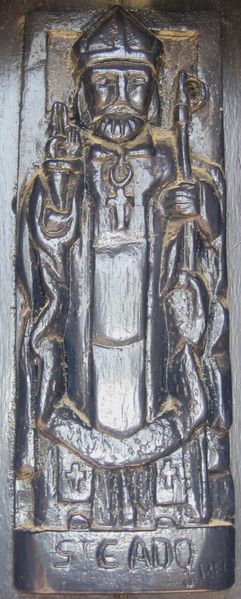Cadoc went on pilgrimages to both Jerusalem and Rome and was distressed that the Synod of Llanddewi Brefi was held during one of these absences. He came into conflicts with kings Arthur, Maelgwn of Gwynedd and Rhain Dremrudd of Brycheiniog. At one time, he apparently lived as a hermit with Saint Gildas on an island in the Bay of Morbihan, off Vannes in Brittany. There are chapels dedicated to him at Belz and Locoal-Mendon in Morbihan and at Gouesnac'h in Finist�re, where he is called upon to cure the deaf. His name is also the basis of some thirty Breton place-names.
Cadoc later moved on to 'Beneventum'. Beneventum is not firmly identified. It is variously suggested as Benevento in Italy or, perhaps more likely, the Roman town of Bannaventa (5 kilometers east of Daventry in Northamptonshire) on the edge of Saxon territory in Britain. This latter hypothesis proposes that it was overrun by Saxons at this time, thus explaining both the killing of Cadoc and the prohibition on Britons entering the town to recover his body.
Cadoc, with Illtud, is one of the three knights said to have become keepers of the Holy Grail. At Caerleon, a Roman centre of Monmouthshire, the much-rebuilt church dedicated to St Cadoc, though of Norman origin, stands on the foundations of the Roman legion headquarters, a sign of the Christianization of Roman sites after the legions departed Britannia. It may memorialize an early cell of Cadoc's, although an old tradition suggests that, in this case, Cadoc is a corruption of Cadfrod. | 








